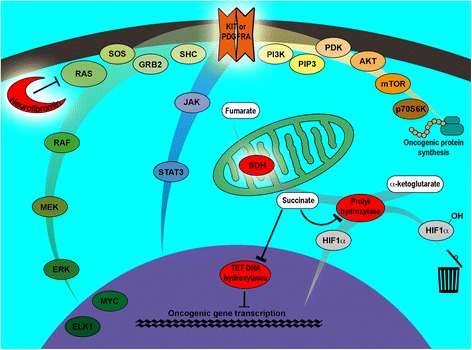Fig. 1.

Molecular triggers and intracellular pathways involved in syndromic GIST arousal. Syndromic GISTs reported so far hinge upon alterations of one of the following (evidenced with a halo): KIT, PDGFRA, neurofibromin or SDH. KIT and PDGFRA activation initiates a downstream signaling involving multiple pathways: RAS/RAF/MEK/ERK (MAPK) (left, green hue); JAK/STAT3 (centre, blue hue); and PI3K/AKT/mTOR (top right, yellow/brown hue), stimulating oncogenic gene transcription or protein synthesis. In NF1-associated GISTs, tumoral inactivation of the WT neurofibromin impairs its RAS inhibiting effect, resulting in the activation of MAPK cascade downstream to KIT and PDGFRA. Impairment of the SDH enzymatic complex prevents succinate conversion to fumarate. Accumulated succinate inhibits prolyl-hydroxylase; the missed hydroxylation of HIF1-α prevents the degradation of this molecule which, consequently, heterodimerizes with HIF1-β and translocates into the nucleus acting as an oncogenic transcription factor. Furthermore, succinate accumulation inhibits TET DNA hydroxylases resulting in impaired conversion of 5-methylcytosine to 5-hydroxymethylcytosine, required for DNA demethylation, thereby influencing gene expression
